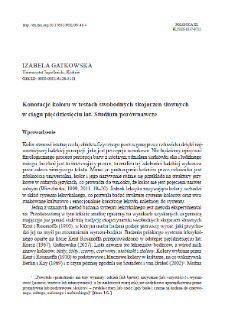
Object
Title: Color connotations in free word association tests over fifty years. A comparative study
Publisher:
Instytut Języka Polskiego Polskiej Akademii Nauk
Place of publishing:
Instytut Języka Polskiego PAN,
Abstract:
The article presents an analysis of lexical data obtained by a free word association experiment in two studiesseparated by 50 years (Kurcz 1967, Gatkowska 2017: 1000 and 900 subjects respectively). Comparativeanalysis was used to analyze the names of colors (white, yellow, black, red, blue and green) and their experimentalconnotations. The gap of 50 years revealed the stability of meanings (semantic connotations) resultingfrom the fact that a given color is an inherent feature (e.g. white - snow), as well as stability of conventions(e.g. white - purity, innocence) and the simultaneous variability of extra-linguistic facts, e.g. thenumerous lexical connotations of red in the Kurcz study, motivated by the political situation of Poland at thetime, that are not present in the contemporary experiment, or new color connotations ( e.g. black - elegant,green - money). In both experiments one can see the use of metonymy to connect a color name and a person.
References:
Berlin, B., Kay, P. (1969). Basic Color Terms: Their Universality and Evolution. Berkeley: University of California Press.
Church, K.W., Hanks, P. (1990). Word Association Norms, Mutual Information, and Lexicography, Computational Linguistics, 16(1), s. 22–29.
Clark, H.H. (1970).Word Associations and Linguistic Theory. W: J. Lyons (red.), New Horizon in Linguistics (s. 271–286). Middlesex: Penguin Books Ltd, Harmondsworth.
Deese, J. (1965). The Structure of Associations in Language and Thought. Baltimore: Johns Hopkins University Press.
Gatkowska, I. (2017). Eksperymentalna sieć leksykalna języka polskiego. Kraków: Wydawnictwo Uniwersytetu Jagiellońskiego.
Jurek, K. (2011). Znaczenie symboliczne i funkcje koloru w kulturze. Kultura, Media, Teologia, 6, s. 68–80.
Kent, G.H., Rosanoff, A.J. (1910). A study of association in insanity. American Journal of Insanity, 67, s. 37–96, 317–390.
Korzycki, M., Gatkowska, I., Lubaszewski, W. (2017). Can Human Association Norm Evaluate Machine- -Made Association Lists. W: B. Sharp, F. Sedes, W. Lubaszewski (red.), Cognitive Approach to Natural Language Processing (s. 21–40). London–Oxford: ISTE/ Elsevier.
Kurcz, I. (1967). Polskie normy skojarzeń swobodnych na 100 słów z listy Kent – Rosanoffa. Studia Psychologiczne, VIII, s. 122–255.
Lubaszewski, W., Gatkowska, I. (2013). Struktura semantyczna języka naturalnego. W: I. Gatkowska, W. Lubaszewski (red.), Interfejs dla osób z dysfunkcją wzroku. Model kognitywny i przykład dobrej praktyki (s. 47–106). Kraków: Wydawnictwo Uniwersytetu Jagiellońskiego.
Lyons, J.L. (1968). Introduction to Theorethical Linguistics. Cambridge: Cambridge University Press.
Lyons, J. (red.) (1970). New Horizon in Linguistics. Middlesex: Penguin Books Ltd, Harmondsworth.
Nęcki, Z., Sowa, I., Rosiński, J. (1999). Psychologia reklamy. W: A.S. Barczak, A. Pitrus (red.), Ze świata reklamy. Kraków: Wydawnictwo Uniwersytetu Jagiellońskiego.
Rapp, R. (2002). The Computation of Word Associations: Comparing Syntagmatic and Paradigmatic Approaches. Proceedings of the 19th International Conference on Computational Linguistics, Taipei, vol. 1 (s. 1–7). Stroudsburg: Association for Computational Linguistics.
Saunders, B., Brakel, J. (2002). The Trajectory of Color. Perspectives on Science, 10 (3), s. 302–355. Pobrane z https://www.muse.jhu.edu/article/43328 (20.03.20).
Sharp, B., Sedes, F., Lubaszewski, W. (red.) (2017). Cognitive Approach to Natural Language Processing. London–Oxford: ISTE/ Elsevier.
Tokarski, R. (2004). Semantyka barw we współczesnej polszczyźnie. Lublin: Wydawnictwo UMCS.
Wierzbicka, A. (1999). Znaczenie nazw kolorów i uniwersalia widzenia. W: A. Wierzbicka, Język – umysł – kultura, wybór prac pod red. J. Bartmińskiego (s. 405–449). Warszawa: Wydawnictwo Naukowe PWN.Wierzbicka, A. (2011). Uniwersalia ugruntowane empirycznie. Teksty Drugie, 1/2, s. 13–30.
Relation:
Volume:
Start page:
End page:
Detailed Resource Type:
Format:
Resource Identifier:
10.17651/POLON.40.4 ; oai:rcin.org.pl:162537
Language:
Language of abstract:
Rights:
Terms of use:
Copyright-protected material. May be used within the limits of statutory user freedoms
Access:
Object collections:
- Digital Repository of Scientific Institutes > Partners' collections > Institute of Polish Language PAS
- Digital Repository of Scientific Institutes > Partners' collections > Institute of Polish Language PAS > Serials
- Digital Repository of Scientific Institutes > Partners' collections > Institute of Polish Language PAS > Filds of science > Humanities > Linguistics
- Digital Repository of Scientific Institutes > Partners' collections > Institute of Polish Language PAS > Filds of science > Humanities > Linguistics > Modern Polish Language
- Digital Repository of Scientific Institutes > Partners' collections > Institute of Polish Language PAS > Offprint
- Digital Repository of Scientific Institutes > Literature > Journals/Articles
Last modified:
Feb 19, 2021
In our library since:
Feb 19, 2021
Number of object content downloads / hits:
466
All available object's versions:
https://www.rcin.org.pl/publication/196743
Show description in RDF format:
Show description in RDFa format:
Show description in OAI-PMH format:
| Edition name | Date |
|---|---|
| Konotacje koloru w testach swobodnych skojarzeń słownychw ciągu pięćdziesięciu lat. Studium porównawcze | Feb 19, 2021 |

 INSTYTUT ARCHEOLOGII I ETNOLOGII POLSKIEJ AKADEMII NAUK
INSTYTUT ARCHEOLOGII I ETNOLOGII POLSKIEJ AKADEMII NAUK
 INSTYTUT BADAŃ LITERACKICH POLSKIEJ AKADEMII NAUK
INSTYTUT BADAŃ LITERACKICH POLSKIEJ AKADEMII NAUK
 INSTYTUT BADAWCZY LEŚNICTWA
INSTYTUT BADAWCZY LEŚNICTWA
 INSTYTUT BIOLOGII DOŚWIADCZALNEJ IM. MARCELEGO NENCKIEGO POLSKIEJ AKADEMII NAUK
INSTYTUT BIOLOGII DOŚWIADCZALNEJ IM. MARCELEGO NENCKIEGO POLSKIEJ AKADEMII NAUK
 INSTYTUT BIOLOGII SSAKÓW POLSKIEJ AKADEMII NAUK
INSTYTUT BIOLOGII SSAKÓW POLSKIEJ AKADEMII NAUK
 INSTYTUT CHEMII FIZYCZNEJ PAN
INSTYTUT CHEMII FIZYCZNEJ PAN
 INSTYTUT CHEMII ORGANICZNEJ PAN
INSTYTUT CHEMII ORGANICZNEJ PAN
 INSTYTUT FILOZOFII I SOCJOLOGII PAN
INSTYTUT FILOZOFII I SOCJOLOGII PAN
 INSTYTUT GEOGRAFII I PRZESTRZENNEGO ZAGOSPODAROWANIA PAN
INSTYTUT GEOGRAFII I PRZESTRZENNEGO ZAGOSPODAROWANIA PAN
 INSTYTUT HISTORII im. TADEUSZA MANTEUFFLA POLSKIEJ AKADEMII NAUK
INSTYTUT HISTORII im. TADEUSZA MANTEUFFLA POLSKIEJ AKADEMII NAUK
 INSTYTUT JĘZYKA POLSKIEGO POLSKIEJ AKADEMII NAUK
INSTYTUT JĘZYKA POLSKIEGO POLSKIEJ AKADEMII NAUK
 INSTYTUT MATEMATYCZNY PAN
INSTYTUT MATEMATYCZNY PAN
 INSTYTUT MEDYCYNY DOŚWIADCZALNEJ I KLINICZNEJ IM.MIROSŁAWA MOSSAKOWSKIEGO POLSKIEJ AKADEMII NAUK
INSTYTUT MEDYCYNY DOŚWIADCZALNEJ I KLINICZNEJ IM.MIROSŁAWA MOSSAKOWSKIEGO POLSKIEJ AKADEMII NAUK
 INSTYTUT PODSTAWOWYCH PROBLEMÓW TECHNIKI PAN
INSTYTUT PODSTAWOWYCH PROBLEMÓW TECHNIKI PAN
 INSTYTUT SLAWISTYKI PAN
INSTYTUT SLAWISTYKI PAN
 SIEĆ BADAWCZA ŁUKASIEWICZ - INSTYTUT TECHNOLOGII MATERIAŁÓW ELEKTRONICZNYCH
SIEĆ BADAWCZA ŁUKASIEWICZ - INSTYTUT TECHNOLOGII MATERIAŁÓW ELEKTRONICZNYCH
 MUZEUM I INSTYTUT ZOOLOGII POLSKIEJ AKADEMII NAUK
MUZEUM I INSTYTUT ZOOLOGII POLSKIEJ AKADEMII NAUK
 INSTYTUT BADAŃ SYSTEMOWYCH PAN
INSTYTUT BADAŃ SYSTEMOWYCH PAN
 INSTYTUT BOTANIKI IM. WŁADYSŁAWA SZAFERA POLSKIEJ AKADEMII NAUK
INSTYTUT BOTANIKI IM. WŁADYSŁAWA SZAFERA POLSKIEJ AKADEMII NAUK


































